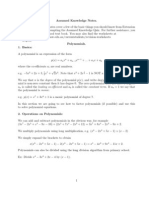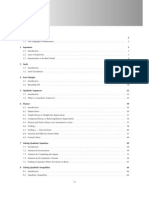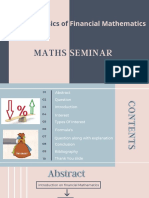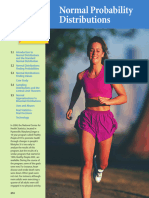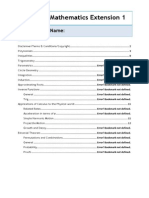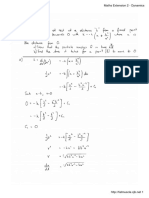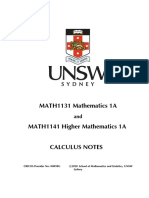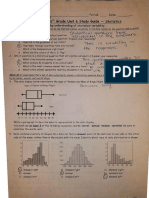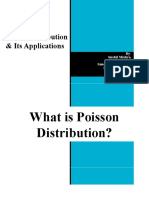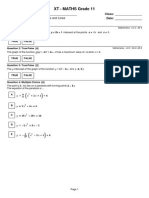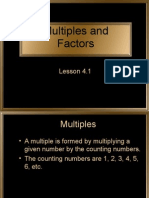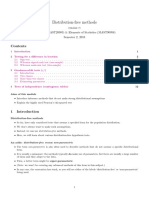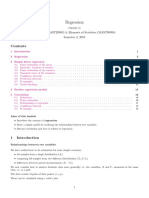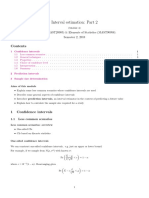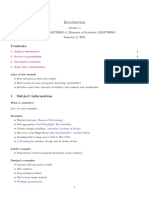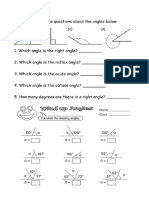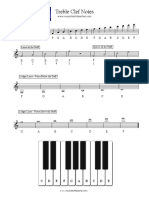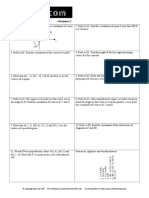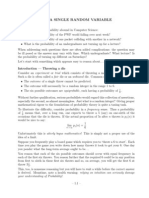Maths Methods Probability Notes
Uploaded by
Anonymous na314kKjOAMaths Methods Probability Notes
Uploaded by
Anonymous na314kKjOAFree download & print from www.itute.
com
Do not reproduce by other means
Copyright itute.com 2005
b
Pr (B = b )
0
9/36
1
18/36
c
Pr (C = c )
0
30/36
2
6/36
2
9/36
Example 3 Probability experiment: An unbiased coin is tossed
three times and the result (H or T) of each toss is recorded.
Probability
Probability experiment, outcomes and sample space
An experiment is the process of collecting data that shows
variation in its outcomes. The set of all possible distinct
outcomes is called the sample space of the experiment.
Examples of random variables:
X: Number of tails in the three tosses.
Y: Difference between the number of heads and the number of
tails in the three tosses.
W: Square of the number of heads in the three tosses.
Probability experiment, discrete random variables and
probability distributions in table form
Probability distributions:
Example 1 Probability experiment: A fair die is rolled and the
uppermost number is recorded.
Examples of discrete random variables (denoted by capital
letters):
P: The number that appears uppermost.
Q: Number of odd uppermost numbers.
R: Number of uppermost numbers that are less than 3.
Probability distributions of P, Q and R (each one is displayed as
a table showing the values of the random variable and the
corresponding probabilities):
x
Pr (P = x )
1
1/6
2
1/6
x
Pr (Q = x )
0
3/6
1
3/6
x
Pr (R = x )
0
4/6
1
2/6
3
1/6
4
1/6
5
1/6
6
1/6
Pr = 1 .
Examples of discrete random variables:
A: The difference of the two uppermost numbers.
B: Number of even uppermost numbers.
C: Number of equal uppermost numbers.
Copyright 2005 itute.com
x
Pr (W = x )
2
8/36
3
6/36
4
4/36
5
2/36
1
6/8
1
3/8
2
3/8
3
1/8
1
3/8
4
3/8
9
1/8
3
2/8
0
1/8
In examples 1, 2 and 3, the outcomes in each experiment are
equally likely, the probabilities can be calculated by
number.of . favourable.outcomes
.
probability =
total.number.of .outcomes
Example 4 A probability experiment has the probability
distribution of the discrete random variable V shown in the
following table.
(a)
(b)
(c)
(d)
(e)
Example 2 Probability experiment: Two fair dice are rolled and
the uppermost numbers are recorded.
Probability distributions:
a
0
1
Pr ( A = a ) 6/36 10/36
x
Pr (Y = x )
x
Pr (V = x )
Notes: (1) 0 Pr 1 .
(2) For a probability distribution,
0
1/8
x
Pr ( X = x )
A random variable X is a numerical valued function defined on a
sample space, i.e. if e is an outcome of the sample space, then
X (e ) is a numerical value assigned to e.
1.3
0.31
1.2
0.22
10.3
0.4
11.1
0.07
State all the possible values of V.
State the mode of the distribution of V.
Find the probability that V < 10.3 .
Find the probability that V < 1.3 .
Find the probability that 0 < V < 15 .
(a) Possible values of V are: 1.3, 1.2, 10.3 and 11.1. There are
only four because
Pr = 0.31 + 0.22 + 0.4 + 0.07 = 1
(b) Mode is the value of a random variable that has the highest
probability. In this example, the mode is 10.3.
(c)
Pr (V < 10.3) = Pr (V = 1.3) + Pr (V = 1.2) = 0.31 + 0.22 = 0.53
(d) Pr (V < 1.3) = Pr (V = 1.3) + Pr (V = 1.2) = 0.31 + 0.22 = 0.53
(e) Pr (0 < V < 15) = Pr (V = 1.2) + Pr (V = 10.3) + Pr (V = 11.1)
= 0.22 + 0.4 + 0.07 = 0.69 .
Alternatively,
Pr (0 < V < 15) = 1 Pr (V = 1.3) = 1 0.31 = 0.69 .
Probability
Probability functions of discrete random variables
Expected value and variance of a discrete random variable
The probability distribution of a discrete random variable can be
specified by a rule and some parameters in some cases instead of
a table, e.g. for the discrete random variable X in example 3, the
n
rule is p(x ) = Pr ( X = x )= n C x (k ) for x = 0,1,2,3 , where n = 3
1
and k = are the parameters of the probability distribution of
2
X.
The commonly used measure of the centre of a probability
distribution of a random variable X is called the expected value
(the mean, or expectation) of X, and it is denoted as E ( X ) , or
X . If the random experiment is repeated many times and the
average value of the random variable is calculated, it approaches
the expected value as the number of repetitions increases.
Example 1 Given the rule of the probability function for
discrete random variable H, p(x ) = Pr (H = x ) = 0.1 x 2 + 1 for
x = 1,0,1,2 , set up a table for the probability distribution of H.
x
Pr (H = x )
1
0.2
0
0.1
1
0.2
Note: For p(x ) to be a probability function,
Other numerical measures of centre are median and mode of a
random variable.
The median m of random variable X has the following
properties: Pr ( X m ) 0.5 and Pr ( X m ) 0.5 .
The mode of X is the value of X that has the highest probability.
The spread of the probability distribution is measured by a
number called the variance of X, and it is denoted as Var ( X ) .
Another number called the standard deviation of X is often
used instead of the variance to measure the spread. It is denoted
2
0.5
p(x ) = 1 .
by sd ( X ) , or X , and sd ( X ) = Var ( X ) . In many cases, if the
random experiment is repeated many times, 68% of the
recorded values of X lie within one X of X , and 95% of the
Example 2 Given the rule of the probability function for
x2
1
2
e
for
e+2 e
x = 1,0,1 , set up a table for the probability distribution of K.
discrete random variable K, p(x ) = Pr (K = x ) =
Show that
p(x ) = 1 .
Calculation of expected value of a discrete random variable
1
0.274
x
Pr (K = x )
p(x ) = Pr = e + 2
0
0.452
+
e
e+2 e
e
e+2 e
1
0.274
X = E ( X ) = x Pr ( X = x )
e+2 e
Example 1 Find the expected value of the following probability
distribution.
e+2 e
=1
Example 3 Five cards are drawn from a deck of 52 playing
cards without replacement. Let the discrete random variable S be
the number of diamond cards in the five drawn cards. The
probability function for S is given by
13
C x 39 C 5 x
p(x ) = Pr (S = x ) =
for x = 0,1,2,3,4,5 .
52
C5
The parameters are 52, 13 and 5.
Use the probability function to set up a table for the probability
distribution of S.
x
Pr (S = x )
0
0.222
recorded values of X lies within 2 X of X .
in a single trial of the random experiment,
Pr ( X + ) 0.68 , and
Pr ( 2 X + 2 ) 0.95 .
1
0.411
Note: Due to rounding errors,
2
0.274
3
0.082
4
0.011
p(x ) = 1.005 1 .
5
0.005
x
Pr ( X = x )
2
0.26
0
0.33
1
0.38
10
0.03
E ( X ) = 2(0.26 ) + 0(0.33) + 1(0.38) + 10(0.03) = 0.16
Example 2 Find the expected value of X with probability
x
1 3
function Pr ( X = x )= 3C x
4 4
3 x
for x = 0,1,2,3 .
0
3
1
2
2
1
1 3
1 3
1 3
E (x ) = 0 3C 0 + 1 3 C1 + 2 3C 2
4 4
4 4
4 4
3
0
1 3
+ 3 3C 0 = 0.75 .
4 4
Note: It would be easier to set up the probability distribution
table and use it to calculate E ( X ) . See example 2 in the next
section.
Copyright 2005 itute.com
Probability
Calculation of Var and of a discrete random variable
x
Pr ( X = x )
The variance of discrete random variable X is defined as
2
Var ( X ) = E ( X X ) =
(x X )2 Pr ( X = x ) .
-3
0.08
-2
0.13
-1
0.2
0
0.35
1
0.18
2
0.06
X = 3(0.08) + (2)(0.13) + (1)(0.2) + 0(0.35) + 1(0.18) + 2(0.06 ) = 0.4
It can be shown that the above definition is equivalent to
2
2
Var ( X ) = E X 2 ( X ) =
x 2 Pr ( X = x ) ( X ) .
( )
Set up the probability distribution table for X.
E ( X ) = ( 3)2 (0.08) + ( 2 )2 (0.13) + ( 1)2 (0.2) + 02 (0.35) + 12 (0.18) + 2 2 (0.06) ( 0.4 )2
= 1.7
The last formula is easier to use than the first in calculating
variance.
X = 1.7 1.3
Example 1 Calculate the variance and standard deviation of the
following discrete probability distribution.
Pr ( X + ) = Pr ( 1.7 X 0.9 ) = 0.2 + 0.35 = 0.55
Pr ( 2 X + 2 ) = Pr ( 3.0 X 2.2)
= 0.08 + 0.13 + 0.2 + 0.35 + 0.18 + 0.06 = 1 .
x
Pr ( X = x )
2
0.26
0
0.33
1
0.38
10
0.03
Firstly calculate the mean of X, X = E ( X ) = 0.16 (See previous
example 1).
2
Var ( X ) = ( 2) (0.26 ) + 0 2 (0.33) + 12 (0.38) + 10 2 (0.03) 0.16 2
4.4
Expected value and variance of random variable Y = kX + b
E (Y ) = E (kX + b ) = kE ( X ) + b
Var (Y ) = Var (kX + b ) = k 2Var ( X )
sd (Y ) = sd (kX + b ) = k .sd ( X )
X = Var ( X ) = 4.4 2.1 .
Example 2 Find the variance and standard deviation of X with
x
1 3
probability function Pr ( X = x )= 3C x
4 4
3 x
for x = 0,1,2,3 .
Pr ( X = x )
0
27
64
1
27
64
E ( X ) = 0.16 , Var ( X ) = 4.4 , sd ( X ) = 2.1 .
E (Y ) = E (2 X 3) = 2 E ( X ) 3 = 2 0.16 3 = 2.68
Var (Y ) = Var (2 X 3) = 2 2 Var ( X ) = 4 4.4 = 17.6
Set up the probability distribution table for X.
x
Example 1 Find the expected value, the variance and the
standard deviation of Y = 2 X 3 , where X is defined in the
previous example 1.
2
9
64
3
1
64
sd (Y ) = sd (2 X 3) = 2.sd ( X ) = 2 2.1 = 4.2 or
sd (Y ) = Var (Y ) = 17.6 = 4.2
Example 2 The probability distribution of the weekly sales, X,
of a particular brand of iPod has = 5.7 and = 2.8 . If the
fixed cost in selling this brand of iPod is $35 per week and the
1
9
27
27
Var ( X ) = 0 2 + 12 + 2 2 + 3 2 0.75 2 = 0.5625 profit on each unit sold is $38, write down the random variable
64
64
64
64
Y, the weekly net profit, in terms of X. Hence find the expected
weekly net profit and the standard deviation of the weekly net
X = 0.5625 = 0.75
profit. Find the range of weekly net profit that the shopkeeper
expects to get with 0.68 chances.
Example 3 Calculate the mean, variance and standard deviation
of the following probability distribution.
Y = 38 X 35
Find Pr ( X + ) and Pr ( 2 X + 2 ) .
E (Y ) = 38 E ( X ) 35 = 38 5.7 35 = 181.60
sd (Y ) = 38 sd ( X ) = 38 2.8 = 106.40
27 27 9 1
+ 1 + 2 + 3 = 0.75
64 64 64 64
X = 0
The shopkeeper expects Pr ( Y + ) 0.68 ,
(181.60 106.40) Y (181.60 + 106.40) , i.e. 75.20 Y 288 .
Copyright 2005 itute.com
Probability
Bernoulli trials and Markov chains
Here we consider experiments consisting of successive
repetitions. Each repetition is called a trial. Furthermore, we
assume that there are only two possible results (success S or
failure F) for each trial. The use of S and F is to emphasize the
point that they are the only possible results and do not bear the
same connotation as success or failure in real life, e.g. failing an
exam may be labeled as a success. For an experiment consisting
of 5 trials, a possible outcome as an example is SFFSF.
Let p be the probability of success and 1 p = q is the
probability of failure in a trial.
If p and hence q remain constant from trial to trial, then we say
the experiment consists of Bernoulli trials.
3!
is the definition of 3 C1 or 3 C 2 .
1!2!
In general for a sequence consisting of x Ss and (n x ) Fs, the
number of arrangements of S and F is n C x or n C n x .
For an experiment consisting of n Bernoulli trials,
n x
Pr ( X = x )= n C x p x (1 p ) , x = 0,1,2,3,...., n . This is known
as the binomial distribution of X. The number of trials n and
the probability of success p are the parameters of the
distribution. A binomial distribution with parameters n and p is
denoted as Bi(n, p ) .
( )
Markov chain: Consider an experiment consisting of 3 trials. In
the first trial, p and q are equal. In the subsequent trials, p and q
depend on the preceding trial result.
If p and hence q depend only on the preceding trial result, then
we say the experiment is a Markov chain.
Trial 1
The following tree diagrams serve to highlight the difference
between the two experiments (consisting of 3 trials each).
1/4
Trial 2
S
1/6
1/6
SSS
5/6
1/6
F
S
SSF
SFS
5/6
1/6
F
S
SFF
FSS
5/6
5/6
1/6
F
S
FSF
FFS
5/6
FFF
Pr ( X = x )
Note:
1 5
1
6 6
1
2
2
1
1 5
3
6 6
1 5
3
6 6
3
2
1 5
1
6 6
Pr ( X = x ) = 1 .
The numbers 1, 3, 3, 1 in the probability calculations are the
number of ways in arranging S and F in a sequence, e.g. for the
sequence consisting of 2 indistinguishable Ss and 1F, there are
3!
= 3 arrangements. They are SSF, SFS and FSS.
1!2!
Copyright 2005 itute.com
F
S
SSF
SFS
2/5
1/4
F
S
SFF
FSS
3/4
3/5
F
S
FSF
FFS
2/5
FFF
= Pr (SFF ) + Pr (FSF ) + Pr (FFS )
Define random variable X on the sample space as the number of
successes in an outcome.
Outcome with X = 0 is: FFF
Outcomes with X = 1 are: SFF, FSF, FFS
Outcomes with X = 2 are: SSF, SFS, FSS
Outcome with X = 3 is: SSS
Probability distribution of X:
x
0
3/4
3/5
1 2 2
Pr ( X = 0) = Pr (FFF ) = = 0.08
2 5 5
Pr ( X = 1) = Pr (SFF FSF FFS )
5/6
SSS
Define random variable X on the sample space as the number of
successes in an outcome.
1/6
1/2
2/5
1/4
5/6
3/5
Trial 3 Outcomes
1/6
3/4
Trial 3 Outcomes
1/2
Bernoulli trials: Roll a fair die 3 times. Success means getting 1,
1
1 5
and failure means not getting 1. p = and q = 1 = .
6
6 6
Trial 1
Trial 2
1 3 2 1 3 3 1 2 3
= + + = 0.495
2 4 5 2 5 4 2 5 5
Pr ( X = 2) = Pr (SSF SFS FSS )
= Pr (SSF ) + Pr (SFS ) + Pr (FSS )
1 1 3 1 3 3 1 3 1
= + + = 0.39375
2 4 4 2 4 5 2 5 4
1 1 1
Pr ( X = 3) = Pr (SSS ) = = 0.03125
2 4 4
Probability distribution of X:
x
0
Pr ( X = x )
0.08
Note:
Pr( X = x) = 1 .
1
0.495
2
0.39375
3
0.03125
The two distributions above are typical examples of discrete
probability distributions.
Probability
Expected value and variance of random variable X with a
binomial distribution
Example 2 In a science experiment, a student has a 40% chance
of getting results. How many times the experiment should be
performed if the student wishes to be 95% confident that (a) at
For a binomial random variable X with parameters n and p, it can least one experiment (b) at least two experiments, will be
successful?
be shown that E ( X ) =
x Pr ( X = x ) = np and
( )
Var ( X ) = E X 2 ( X ) = np(1 p ) .
2
Instead of using the general methods for discrete random
variables in calculating E ( X ) and Var ( X ) , a quicker way is to
use E ( X ) = np and Var ( X ) = np(1 p ) .
Note: The last two formulas are for binomial distributions only.
Example 1 From past experience 5% of students of a large
school are out of uniform on any school day. Five students are
selected randomly from the school to check for uniform. (a) Set
up the probability distribution of the number of students out of
uniform. (b) Find the probability that at most one is out of
uniform. (c) Calculate the mean and standard deviation of the
distribution.
Assume the sequence of experiments forms a sequence of
Bernoulli trials, and has a binomial distribution with p = 0.4 and
n is to be found.
(a) Pr ( X 1) 0.95 , 1 Pr ( X = 0 ) 0.95 ,
Pr ( X = 0 )= 5 C 0 (0.05) (0.95) = 0.774
0
Pr ( X = 1)= C1 (0.05) (0.95) = 0.204
5
Pr ( X = 2 )= 5 C 2 (0.05) (0.95) = 0.021
2
i.e. n 6 .
See part (b) for alternative methods in solving the inequality.
(b) Pr ( X 2 ) 0.95 , 1 Pr ( X = 0) Pr ( X = 1) 0.95 ,
Pr ( X = 0 ) + Pr ( X = 1) 0.05 ,
n
)(
( )( )
) 0.05 .
C 0 0.4 0 0.6 n + n C1 0.41 0.6 n 1 0.05 ,
0.6 + 0.4n 0.6
n 1
Graphics calculator: Enter equation y = 0.6 n + 0.4n 0.6 n 1 ,
2nd TBLSET, TblStart = 1, Tbl = 1, Indpnt: Auto Ask,
Depend: Auto Ask, 2nd TABLE.
Scroll down to where Y1 is less than 0.05, i.e. n 10 .
Alternatively, use graphics calculator to sketch
y = 0.6 n + 0.4n 0.6 n 1 and y = 0.05 .
Find the intersection at n = 9.82 .
For 0.6 n + 0.4n 0.6 n 1 0.05 , n 10 .
If p = 0.5 , the graph of the distribution is bell-shaped and
symmetrical about the mean = np .
Pr ( X = 4)= 5 C 4 (0.05) (0.95) = 0.000
4
log e 0.05
= 5.8645 ,
log e 0.6
Graphs of binomial distributions
Pr ( X = 3)= 5 C 3 (0.05) (0.95) = 0.001
3
0.6 n 0.05 , n log e 0.6 log e 0.05 , n
(a)
Probability experiment: Checking 5 students for school uniform.
Number of trials n = 5 (5 students)
Success: Out of uniform
Probability of success p = 0.05 (5%)
Random variable X: Number out of uniform.
The experiment can be considered as a sequence of 5 Bernoulli
trials, and X has a binomial distribution.
)(
Pr ( X = 0 ) 0.05 , n C 0 0.4 0 0.6 n 0.05 ,
Pr ( X = 5)= 5 C 5 (0.05) (0.95) = 0.000
5
These probabilities can be obtained by graphics calculator,
2nd DISTR 0: binompdf (5, 0.05) ENTER.
Binomial distribution of X:
x
0
1
Pr ( X = x )
0.774 0.204
2
0.021
3
0.001
4
0.000
5
0.000
(b) Pr (at.most.one ) = Pr ( X 1) = Pr ( X = 0) + Pr ( X = 1)
= 0.774 + 0.204 = 0.978 .
If p < 0.5 , the graph is positively skewed.
This probability can be obtained by graphics calculator,
2nd DISTR A: binomcdf (5, 0.05, 1) ENTER. 0.977
The small discrepancy is due to rounding errors.
(c) X = np = 5 0.05 = 0.25 .
Var ( X ) = np(1 p ) = 5 0.05 0.95 = 0.2375 ,
X = 0.2375 = 0.49 .
Copyright 2005 itute.com
Probability
If p > 0.5 , the graph is negatively skewed.
Calculation of expected value, variance and standard
deviation of a continuous random variable
For continuous random variable X with probability density
function f (x ) ,
X = E ( X ) = xf (x )dx ,
Var ( X ) = E ( X X ) =
2
( )
Var ( X ) = E X 2 ( X ) =
2
X = Var ( X ) .
If n becomes large, all binomial distributions tend towards bellshape irrespective of the value of p.
Continuous random variables and probability density
functions
In many experiments a random variable can take any real value,
but its exact value in an attempt of the experiment cannot be
determined, due to the limitations of measuring instrument and
the person taking the measurement, e.g. measuring the height H
of a randomly chosen person from a large number of people. It is
more appropriate to consider a range of values (an interval) for
the height rather than a single value. Hence the assigned
probability for H = h cm is zero, i.e. Pr (H = h ) = 0 , and
0 Pr (a < H < b ) 1 .
A random variable that fits the above descriptions is called a
continuous random variable. The probability distribution of a
continuous random variable is given by its probability density
function f (x ) such that Pr (a < X < b ) =
(x X )2 f (x )dx
or
x 2 f (x )dx ( X ) ,
2
For many natural continuous probability distributions,
Pr ( < X < + ) 0.68 , and
Pr ( 2 < X < + 2 ) 0.95 .
Calculation of median and mode of a continuous random
variable
The median of continuous random variable X with probability
density function f (x ) is defined as the value m of X such that
f (x )dx = 0.5 . Hence
f (x)dx = 0.5 .
m
The mode of continuous random variable X with probability
density function f (x ) is the value M of X such that
f (M ) f (x ) for all real x. The equal sign suggests that there
may be more than one mode in the distribution. If f (x ) is
differentiable for all x, then it is possible in some cases to find
the mode by differentiation (maximum of f (x ) ).
f (x )dx , i.e. area
under the curve f (x ) in the interval (a, b )
If the probability density function is symmetrical about a mode
M, then the median, the mean and M have the same value.
Example 1 Consider the probability density function
2
f (x ) = sin 2 x for 0 < x < and f (x ) = 0 elsewhere.
f (x )
Notes:
(1) For f (x ) to be a probability density function of random
variable X, it must satisfy the conditions: f (x ) 0 for all real x,
and
f (x )dx = 1 .
(2) Do not confuse probability density function f (x ) with
probability function p(x ) discussed earlier. f (x ) is for
continuous random variable and the area under the graph of
f (x ) gives the probability. p(x ) is for discrete random variable
and direct substitution of a value of x gives the probability.
Copyright 2005 itute.com
(a) Show that f (x ) satisfies the requirements of a probability
density function.
(b) Find Pr (1 < X < 2) .
(c) Find the mean, median and mode of X.
(d) Find the variance of X.
(e) Verify that Pr ( < X < + ) 0.68 .
(a) Since sin 2 x is always positive for all x (0, ) ,
f (x ) > 0 for all x (0, ) . Elsewhere, f (x ) = 0 .
f (x ) 0 for all real x.
2
Use graphics calculator to graph y = sin 2 x , 0 x .
f (x )dx . Lower limit x = 0 . Upper limit x = .
xdx = 1 . f (x )dx = 1 .
2nd CALC 7:
sin 2
Probability
(b) Pr (1 < X < 2) =
2
(c) Since f (x ) =
sin
sin 2 x , 0 x is symmetrical about
the mean = median = mode of X =
( )
(d) Var ( X ) = E X 2 ( X ) =
Var ( X ) =
(d) Var ( X ) =
xdx = 0.5835 .
30(x
1
x 5 dx 0.7143 2
x 7 dx 0.7143 2
1
x 7 x 8
1
0.7143 2 = 30
= 30
0.7143 2 = 0.0255 .
8
56
7
0
x 2 f (x )dx ( X )
2
(e) Let 0 < m < 1 be the median of X. Pr ( X < m ) = 0.5 .
m
m
x 2 sin 2 x dx = 2.7899 2.4674 = 0.3225
30 x 4 (1 x )dx = 30 x 4 x 5 dx = 0.5 .
2
2
0
0.5679 = 1.0029, + =
Pr (1.0029 < X < 2.1387 ) =
X = 0.3225 = 0.5679 .
(e)
x 30(x
2.1387
1.0029
+ 0.5679 = 2.1387 ,
sin 2 xdx = 0.6502
x 5 x 6
m5 m6
5
6
= 30
30
5 6 = 0.5 , 12m 10m = 1 .
5
6
Use graphics calculator to find m = 0.7356 .
f (x ) = 30 x 4 (1 x ) for 0 < x < 1 .
(f)
To find the maximum of f (x ) , let f (x ) = 30 4 x 3 5 x 4 = 0 ,
x (4 5 x ) = 0, x = 0.8 , hence the mode is 0.8.
3
Example 2 Consider the probability density function
f (x ) = 30 x 4 (1 x ) for 0 < x < 1 and f (x ) = 0 elsewhere.
(a) Show that f (x ) satisfies the requirements of a probability
density function.
(b) Find Pr ( X < 0.5) .
(c) Find the mean of X.
(d) Find the variance of X.
(e) Use calculus to find the median of X.
(f) Find the mode of X.
Normal distributions examples of continuous probability
distributions
A normal distribution N , 2 has the following probability
density function: f (x ) =
1 x
, where the mean
(a) For 0 < x < 1 , x 4 > 0 and (1 x ) > 0 , f (x ) > 0 .
R and the standard deviation > 0 are the parameters of
the normal distribution.
Note: N ( , 2 ) is the notation used in the study design (2006-
Use graphics calculator to graph y = 30 x 4 (1 x ) , 0 x 1 .
2009), 2 is the variance. You may find in some textbooks the
notation N ( , ) is used.
Elsewhere, f (x ) = 0 . f (x ) 0 for all real x.
f (x )dx . Lower limit x = 0 . Upper limit x = 1 .
30 x (1 x )dx = 1 . f (x )dx = 1 .
Or by calculus. 30 x (1 x )dx = 30(x x )dx
2nd CALC 7:
1
x 5 x 6
1
= 30
= 30
= 1.
5
6
30
0
(b) Pr ( X < 0.5) =
0 .5
30 x 4 (1 x )dx =
0.5
x 5 x 6
0.5 5 0.5 6
= 30
= 30
6
6
5
5
0
(c) E ( X ) =
x30 x 4 x 5 dx =
0 .5
A normal distribution is bell-shaped and symmetrical about its
1
is the maximum, is also
mean . At x = , f ( ) =
2
the mode. Furthermore, Pr ( X < ) = 0.5 and Pr ( X > ) = 0.5
due to the symmetry about the mean. is also the median of
a normal distribution.
30 x 4 x 5 dx
= 0.1094
30(x
1
x 6 dx
x 6 x 7
1
= 30
= 30
= 0.7143
6
7
42
0
Copyright 2005 itute.com
Probability
If = 0 and = 1 , then N (0,1) is called standard normal
distribution. Its random variable is usually denoted as Z.
Transforming a normal distribution to the standard normal
distribution
Any value of the random variable X with the normal distribution
N , 2 can be matched up with a value of the random
variable Z with the standard normal distribution N (0,1) by the
relationship Z =
, such that Pr ( X < x ) = Pr Z <
.
Example 1 = 2 , 2 = 2, = 2 .
Effects of changing and on the graph of N , 2
Increasing (decreasing) the value of causes the graph to
translate to the right (left).
Increasing (decreasing) the value of causes the graph to spread
out (contract) and lowers (raises) the maximum value of f (x ) .
For X = 2 , Z =
For X = 0 , Z =
22
2
02
= 0 . Pr ( X < 2) = Pr (Z < 0 ) = 0.5 .
= 1.414 .
2
Pr ( X < 0 ) = Pr (Z < 1.414 ) = 0.079
Copyright 2005 itute.com
Probability
Example 1 (i) Write down the probability density function
f (x ) for N (2.5,1.5) . (ii) Determine Pr ( X < 3) by (a) finding
the area under the graph of f (x ) , (b) normalcdf (-,-,-,-), and
(c) changing to the standard normal and then normalcdf (-,-).
(iii) Determine Pr (1 < X < 3) by repeating (a), (b) and (c).
(iv) Show that Pr ( 2 < X < + 2 ) 0.95 .
(i)
f (x ) =
1
1.5 2
1 x 2 .5
2 1 .5
(ii)
(a) Pr ( X < 3) =
f (x )dx = 0.63 . Note: the writer used
Example 4 The height of a population is normally distributed
with = 175 cm. If 2% of the population is over 190 cm, find
the standard deviation of the random variable X, the height in
cm.
Given Pr ( X > 190 ) = 0.02 , Pr ( X < 190 ) = 1 0.02 = 0.98 ,
190 175
Pr Z <
= 0.98 .
15
Hence
= invNorm(0.98) = 2.0537 , = 7.3 .
Note: It is not necessary to enter 0 and 1, by default invNorm(_ )
is the inverse of the standard normal distribution.
5 = 5 as the lower limit to evaluate the definite integral.
(b) Pr ( X < 3) = normalcdf ( E 99,3,2.5,1.5) = 0.63 .
3 2.5 1
(c) Z =
= ,
1.5
3
1
Pr ( X < 3) = Pr Z < = normalcdf ( E 99,1 / 3) = 0.63 .
3
(iii)
(a) Pr (1 < X < 3) =
f (x )dx = 0.47 .
(b) Pr (1 < X < 3) = normalcdf (1,3,2.5,1.5) = 0.47 .
1 2.5
(c) Z =
= 1 ,
1.5
1
Pr (1 < X < 3) = Pr 1 < Z < = normalcdf ( 1,1 / 3) = 0.47 .
3
(iv) 2 = 2.5 2 1.5 = 0.5 , + 2 = 2.5 + 2 1.5 = 5.5
Pr ( 0.5 < X < 5.5) = normalcdf ( 0.5,5.5,2.5,1.5) 0.95 .
Example 2 X has a normally distribution with = 80 and
2 = 25 . Find (a) x such that Pr ( X < x ) = 0.8 , and
(b) c > 0 such that Pr ( c < X < + c ) = 0.8 .
= 5.
(a) Pr ( X < x ) = 0.8 , x = invNorm(0.8,80,5) = 84.2 .
(b) Pr ( c < X < + c ) = 0.8 , Pr ( c < X < ) = 0.4 ,
Pr ( X < c ) = 0.1 , c = invNorm(0.1,80,5) = 73.6 ,
c = 73.6 = 80 73.6 = 6.4
Example 3 X has a normally distribution with = 80 and
= 25 . Without using graphics calculator, find (a) c > 0 such
that Pr ( c < X < + c ) = 0.95 , and (b) x such that
Pr ( X < x ) = 0.975 .
2
(a) Since Pr ( 2 < X < + 2 ) = 0.95 , c = 2 = 10 .
(b) Outside the interval 2 < X < + 2 , prob = 0.05,
Example 5 The body-weight of an individual in a population is
normally distributed. If 5% of the population is over 80 kg and
3% is less than 20 kg, find the mean and standard deviation of
the weight of the population.
Given Pr ( X > 80 ) = 0.05 and Pr ( X < 20 ) = 0.03 ,
Pr ( X < 80) = 1 0.05 = 0.95 ,
80
20
Pr Z <
= 0.95 and Pr Z <
= 0.03 .
Hence
80
80
= invNorm(0.95) and
= 1.64485 and
20
20
= invNorm(0.03) .
= 1.88079 .
Solve simultaneously,
80 = 1.64485 .(1)
20 = 1.88079 ..(2)
(1) (2), 60 = 3.52564 , = 17 and = 52
Example 6 The distance in metres that a javelin is thrown by a
competitor follows a normal distribution with a mean of 80.80
and a standard deviation of 4.50. (a) Find the probability that a
javelin is thrown more than 85.00 m. (b) In five throws what is
the probability that the competitor throws more than 85.00 m in
more than 2 occasions? (c) Find the expected number of throws
by the competitor exceeding 85.00 m in 5 throws.
(a) N 80.80,4.50 2 ,
Pr ( X > 85.00 ) = normalcdf (85.00, E 99,80.80,4.50 ) = 0.175 .
(b) Bi (5,0.175) ,
Pr ( X > 2 ) = 1 Pr ( X 2 ) = 1 binomcdf (5,0.175,2)
= 1 0.96 = 0.04 .
(c) Bi (5,0.175) , = E ( X ) = np = 5 0.175 = 0.88 .
Pr ( X > + 2 ) = 0.025 ,
Pr ( X < + 2 ) = 1 0.025 = 0.975 , hence x = + 2 = 90 .
Copyright 2005 itute.com
Probability
Conditional probability
The probability of an event A may or may not depend on the
knowledge of the occurrence of another event B.
The probability of A given the knowledge of B occurring is
denoted by Pr ( A | B ) . This is called conditional probability.
If Pr ( A | B ) = Pr ( A) , then events A and B are independent.
If Pr ( A | B ) Pr ( A) , then events A and B are dependent.
Pr ( A B )
.
Pr (B )
Hence Pr ( A B ) = Pr ( A | B ) Pr (B ) . This is known as the
multiplication rule.
Conditional probability is defined as Pr ( A | B ) =
If A and B are independent, the multiplication rule can be
simplified to Pr ( A B ) = Pr ( A) Pr (B ) .
Conversely, if Pr ( A B ) = Pr ( A) Pr (B ) , then A and B are
independent.
Note: Do not confuse independent events with mutually
exclusive events.
If Pr ( A B ) = 0 , then A and B are mutually exclusive events,
and the addition rule Pr ( A B ) = Pr ( A) + Pr (B ) Pr ( A B )
becomes Pr ( A B ) = Pr ( A) + Pr (B ) .
Example 2 The weight in grams of a potato in a crate is
normally distributed with = 220 and = 10 . Find (a) the
probability that a potato weighs more than 215 grams given that
it is not less than 210 grams, (b) the probability that a potato
weighs less than 215 grams given that it is not less than 210
grams.
(a) Pr ( X > 215) | ( X < 210) = Pr (( X > 215) | ( X 210))
Pr (( X > 215) ( X 210))
=
Pr ( X 210)
Pr ( X > 215) normalcdf (215, E 99,220,10)
=
=
= 0.82 .
Pr ( X 210) normalcdf (210, E 99,220,10)
(b) Pr ( X < 215) | ( X < 210) = Pr (( X < 215) | ( X 210))
Pr (( X < 215) ( X 210))
=
Pr ( X 210 )
Pr (210 X < 215) normalcdf (210,215,220,10 )
=
=
= 0.18 .
Pr ( X 210)
normalcdf (210, E 99,220,10 )
Note: A quicker way,
Pr ( X < 215) | ( X < 210) = 1 Pr ( X > 215) | ( X < 210)
= 1 0.82 = 0.18 .
A Karnaugh table is a useful tool in calculating conditional
probabilities.
A
A
B)
(
)
(
Pr
A
B
Pr
A
Pr (B )
B
Pr ( A B )
Pr ( A B )
Pr (B )
B
Pr ( A)
Pr ( A)
Example 1 A fair coin is tossed 3 times. Let A be the event that
more than 2 heads occurring, and B the event that more than 1
head occurring. Find Pr ( A | B ) and Pr (B | A) .
3
1
1
Pr ( A) = Pr ( X = 3) = = .
8
2
Pr (B ) = Pr ( X > 1) = Pr ( X = 2) + Pr ( X = 3) =
1
.
8
Set up the Karnaugh table:
A
B
1/8
0
B
1/8
3 1 1
+ = .
8 8 2
Pr ( A B ) = Pr ( X = 3) =
A
3/8
1/2
7/8
1/2
1/2
1
Pr ( A B ) 3 / 8 3
=
= .
Pr (B )
1/ 2 4
Pr (B A) 3 / 8 3
Pr (B | A) =
=
= .
Pr ( A)
7/8 7
Pr ( A | B ) =
Copyright 2005 itute.com
Probability
10

